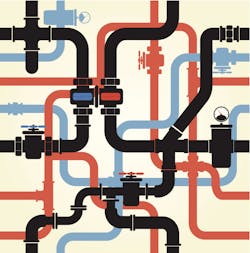I’m happy to see that infrastructure, especially water supply, has been in the news lately, although I retain my jaded skepticism.
The first big story was in the New York Times Magazine, a lengthy profile of the “troublemaker scientist,” Dr. Marc Edwards from Virginia Tech. Dr. Edwards was the guy who blew the whistle on the Flint, Michigan, water crisis. The Times reported that scrawled on the side of an old brick pump house in Flint was some unusual graffiti: “You want our trust? We want Va. Tech.” By Va. Tech, they meant Marc Edwards.
I’ve met Marc Edwards and heard him speak at Plumbing Manufacturers International events and at the International Emerging Technologies Symposium. He’s a disarmingly quiet guy, but quite tenacious as the troublemaker scientist.
Edwards became radicalized by his experience with the Washington, D.C., lead crisis that began in 2001. The fight took nearly a decade and resulted in the 2010 publication by Congress of, “A Public Health Tragedy: How Flawed C.D.C. Data and Faulty Assumptions Endangered Children’s Health in the Nation’s Capital.”
In D.C., Edwards fought against scientific misconduct at the Environmental Protection Agency and at the Centers for Disease Control and Prevention. He refers, in the Times story, to unethical bureaucrats as “pathological lying scumbags."
Like D.C., Flint was caused by misfeasance by public officials switching water supplies and failing to add phosphoric acid and other treatment chemicals to the Flint River water. A Flint citizen, LeeAnne Walters, sent water samples to Edwards’ lab that found lead levels so high that they qualified as hazardous waste. You really should read the entire Times profile of Edwards at http://nyti.ms/2bNghXm.
On the other side of the country, kudos to Los Angeles for its plan to replace hundreds of miles of water supply piping in the city, which sounds great until you consider the scope of the problem. L.A. has 6,800 miles of water supply piping, reported television station KABC, and 2,000 miles of that is more than 80 years old. Last year, the Los Angeles Department of Water and Power replaced 30 miles of pipe.
They were replacing pipe in the Hollywood Hills, not down in the Valley where the plain folks live.
The announcement provided a photo op too good for any politician to pass up, so we were treated to seeing Los Angeles Mayor Eric Garcetti in a ditch, http://bit.ly/2bGJSzr. LADWP crews were replacing a 92-year-old pipe, and the ditch proved irresistible to the mayor with all those cameras present.
They were replacing pipe in the Hollywood Hills, not down in the Valley where the plain folks live. Flint happened because the people were disenfranchised. It’s a modern-day, “The peasants have no bread? Let them eat cake.” The poor have no tap water? Let them drink Fiji.
The American Society of Civil Engineers has given our infrastructure a grade of D+, and said in its report, “Report Card for American Infrastructure,” that we would need to spend $3.6 trillion by 2020 to raise the grade to a B. In contrast, total annual spending by the federal government is around $4 trillion.
How has the infrastructure situation gotten so out of hand? There’s never been any appetite to spend money on infrastructure. I recently heard a political commentator talk about the last time the gas tax, which pays for highway repairs, was increased in 1994. The commentator, who was a staffer on the Senate Finance Committee at the time, said the debate became so contentious that the committee couldn’t even agree on a nickel. They settled on 4.3 cents per gallon.
At what point does water infrastructure become such a crisis that it spurs people to pay for it? The jaded skeptic in me says, “never.”
About the Author
Robert P. Mader
Bob Mader is the Editorial Director for Penton's mechanical systems brands, including CONTRACTOR magazine, Contracting Business and HPAC Engineering, all of which are part of Penton’s Energy and Buildings Group. He has been with CONTRACTOR since 1984 and with Penton since 2001. His passions are helping contractors improve their businesses, saving energy and the issue of safeguarding our drinking water. He is a graduate of the University of Notre Dame with an A.B. in American Studies with a Communications Concentration.
